
2
ENGLISH
GENERAL POWER TOOL SAFETY WARNINGS
WARNING: Read all safety warnings, instructions, illustrations and specifications
provided with this power tool. Failure to follow all instructions listed below may result in
electric shock, fire and/or seriousinjury.
SAVE ALL WARNINGS AND INSTRUCTIONS FOR FUTURE
REFERENCE
The term “power tool” in the warnings refers to your mains-operated (corded) power tool or battery-
operated (cordless) powertool.
1) Work Area Safety
a ) Keep work area clean and well lit. Cluttered or dark areas inviteaccidents.
b ) Do not operate power tools in explosive atmospheres, such as in the presence of
flammable liquids, gases or dust. Power tools create sparks which may ignite the dust
orfumes.
c ) Keep children and bystanders away while operating a power tool. Distractions can
cause you to losecontrol.
2) Electrical Safety
a ) Power tool plugs must match the outlet. Never modify the plug in any way. Do not
use any adapter plugs with earthed (grounded) power tools. Unmodified plugs and
matching outlets will reduce risk of electricshock.
b ) Avoid body contact with earthed or grounded surfaces such as pipes, radiators,
ranges and refrigerators. There is an increased risk of electric shock if your body is earthed
orgrounded.
c ) Do not expose power tools to rain or wet conditions. Water entering a power tool will
increase the risk of electricshock.
d ) Do not abuse the cord. Never use the cord for carrying, pulling or unplugging the
power tool. Keep cord away from heat, oil, sharp edges or moving parts. Damaged
or entangled cords increase the risk of electricshock.
e ) When operating a power tool outdoors, use an extension cord suitable for outdoor
use. Use of a cord suitable for outdoor use reduces the risk of electricshock.
f ) If operating a power tool in a damp location is unavoidable, use a ground
fault circuit interrupter (GFCI) protected supply. Use of a GFCI reduces the risk of
electricshock.
3) Personal Safety
a ) Stay alert, watch what you are doing and use common sense when operating a
power tool. Do not use a power tool while you are tired or under the influence of
drugs, alcohol or medication. A moment of inattention while operating power tools may
result in serious personalinjury.
b ) Use personal protective equipment. Always wear eye protection. Protective
equipment such as dust mask, non-skid safety shoes, hard hat, or hearing protection used for
appropriate conditions will reduce personalinjuries.
c ) Prevent unintentional starting. Ensure the switch is in the off position before
connecting to power source and/or battery pack, picking up or carrying the tool.
Carrying power tools with your finger on the switch or energizing power tools that have the
switch on invitesaccidents.
d ) Remove any adjusting key or wrench before turning the power tool on. A wrench or a
key left attached to a rotating part of the power tool may result in personalinjury.
e ) Do not overreach. Keep proper footing and balance at all times. This enables better
control of the power tool in unexpectedsituations.
f ) Dress properly. Do not wear loose clothing or jewelry. Keep your hair, clothing and
gloves away from moving parts. Loose clothes, jewelry or long hair can be caught in
movingparts.
g ) If devices are provided for the connection of dust extraction and collection facilities,
ensure these are connected and properly used. Use of dust collection can reduce dust-
relatedhazards.
h ) Do not let familiarity gained from frequent use of tools allow you to become
complacent and ignore tool safety principles. A careless action can cause severe injury
within a fraction of asecond.
4) Power Tool Use and Care
a ) Do not force the power tool. Use the correct power tool for your application. The
correct power tool will do the job better and safer at the rate for which it wasdesigned.
b ) Do not use the power tool if the switch does not turn it on and off. Any power tool that
cannot be controlled with the switch is dangerous and must berepaired.
c ) Disconnect the plug from the power source and/or the battery pack from the power
tool before making any adjustments, changing accessories, or storing power tools.
Such preventive safety measures reduce the risk of starting the power toolaccidentally.
d ) Store idle power tools out of the reach of children and do not allow persons
unfamiliar with the power tool or these instructions to operate the power tool.
Power tools are dangerous in the hands of untrainedusers.
e ) Maintain power tools. Check for misalignment or binding of moving parts,
breakage of parts and any other condition that may affect the power tool’s
operation. If damaged, have the power tool repaired before use. Many accidents are
caused by poorly maintained powertools.
f ) Keep cutting tools sharp and clean. Properly maintained cutting tools with sharp cutting
edges are less likely to bind and are easier tocontrol.
g ) Use the power tool, accessories and tool bits, etc. in accordance with these
instructions, taking into account the working conditions and the work to be
performed. Use of the power tool for operations different from those intended could result
in a hazardoussituations.
h ) Keep handles and grasping surfaces dry, clean and free from oil and grease. Slippery
handles and grasping surfaces do not allow for safe handling and control of the tool in
unexpectedsituations.
5) Service
a ) Have your power tool serviced by a qualified repair person using only identical
replacement parts. This will ensure that the safety of the power tool ismaintained.
Safety Instructions for Miter Saws
a ) Miter saws are intended to cut wood or wood-like products, they cannot be used
with abrasive cut-off wheels for cutting ferrous material such as bars, rods, studs,
etc. Abrasive dust causes moving parts such as the lower guard to jam. Sparks from abrasive
cutting will burn the lower guard, the kerf insert and other plasticparts.
b ) Use clamps to support the workpiece whenever possible. If supporting the
workpiece by hand, you must always keep your hand at least 100 mm from either
side of the saw blade. Do not use this saw to cut pieces that are too small to be
securely clamped or held by hand. If your hand is placed too close to the saw blade, there
is an increased risk of injury from bladecontact.
c ) The workpiece must be stationary and clamped or held against both the fence and
the table. Do not feed the workpiece into the blade or cut “freehand” in any way.
Unrestrained or moving workpieces could be thrown at high speeds, causinginjury.
d ) Never cross your hand over the intended line of cutting either in front or behind the
saw blade. Supporting the workpiece “cross handed” i.e. holding the workpiece to the right
of the saw blade with your left hand or vice versa is verydangerous.
e ) Do not reach behind the fence with either hand closer than 100 mm from either side
of the saw blade, to remove wood scraps, or for any other reason while the blade
is spinning. The proximity of the spinning saw blade to your hand may not be obvious and
you may be seriouslyinjured.
f ) Inspect your workpiece before cutting. If the workpiece is bowed or warped, clamp
it with the outside bowed face toward the fence. Always make certain that there
is no gap between the workpiece, fence and table along the line of the cut. Bent or
warped workpieces can twist or shift and may cause binding on the spinning saw
blade while cutting. There should be no nails or foreign objects in theworkpiece.
g ) Do not use the saw until the table is clear of all tools, wood scraps, etc., except
for the workpiece. Small debris or loose pieces of wood or other objects that contact the
revolving blade can be thrown with highspeed.
h ) Cut only one workpiece at a time. Stacked multiple workpieces cannot be adequately
clamped or braced and may bind on the blade or shift duringcutting.
i ) Ensure the miter saw is mounted or placed on a level, firm work surface before use.
A level and firm work surface reduces the risk of the miter saw becomingunstable.
j ) Plan your work. Every time you change the bevel or miter angle setting, make sure
the fence will not interfere with the blade or the guarding system. Without turning
the tool “ON” and with no workpiece on the table, move the saw blade through a complete
simulated cut to assure there will be no interference or danger of cutting thefence.
k ) Provide adequate support such as table extensions, saw horses, etc. for a workpiece
that is wider or longer than the table top. Workpieces longer or wider than the miter
saw table can tip if not securely supported. If the cut-off piece or workpiece tips, it can lift the
lower guard or be thrown by the spinningblade.
l ) Do not use another person as a substitute for a table extension or as additional
support. Unstable support for the workpiece can cause the blade to bind or the workpiece to
shift during the cutting operation pulling you and the helper into the spinningblade.
m ) The cut-off piece must not be jammed or pressed by any means against the
spinning saw blade. If confined, i.e. using length stops, the cut-off piece could get wedged
against the blade and thrownviolently.
n ) Always use a clamp or a fixture designed to properly support round material such
as rods or tubing. Rods have a tendency to roll while being cut, causing the blade to “bite”
and pull the work with your hand into theblade.
o ) Let the blade reach full speed before contacting the workpiece. This will reduce the risk
of the workpiece beingthrown.
p ) If the workpiece or blade becomes jammed, turn the miter saw off. Wait for all
moving parts to stop and disconnect the plug from the power source and/or remove
the battery pack. Then work to free the jammed material. Continued sawing with a
jammed workpiece could cause loss of control or damage to the mitersaw.
q ) After finishing the cut, release the switch, hold the saw head down and wait for
the blade to stop before removing the cut-off piece. Reaching with your hand near the
coasting blade isdangerous.
r ) Hold the handle firmly when making an incomplete cut or when releasing the
switch before the saw head is completely in the down position. The braking action of
the saw may cause the saw head to be suddenly pulled downward, causing a risk ofinjury.

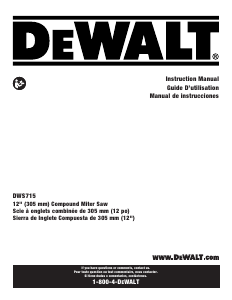


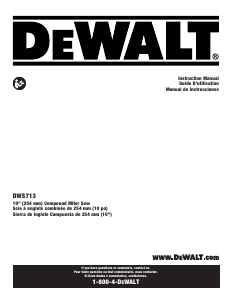
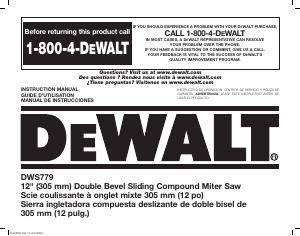
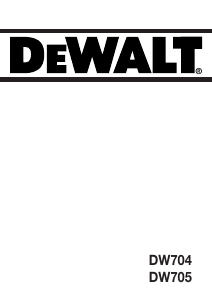
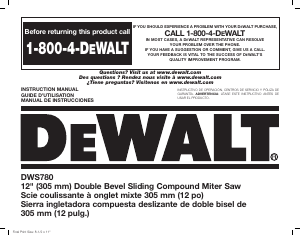

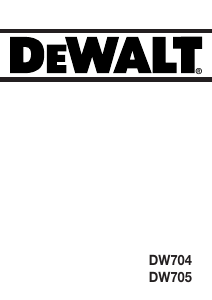
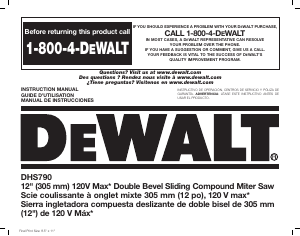
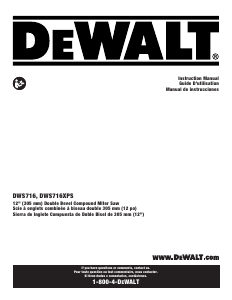
Join the conversation about this product
Here you can share what you think about the DeWalt DWS715 Mitre Saw. If you have a question, first carefully read the manual. Requesting a manual can be done by using our contact form.